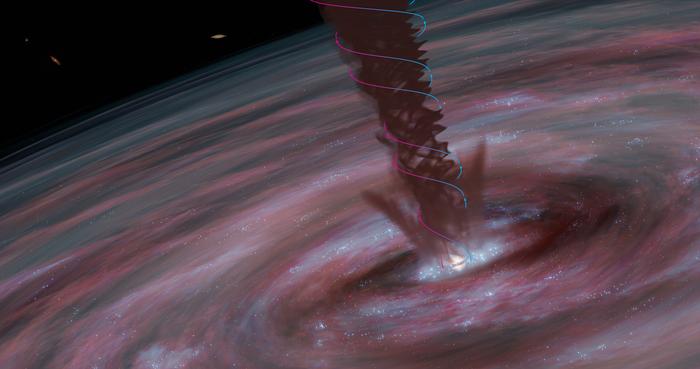New observations reveal a surprising similarity between the growth of supermassive black holes and the birth of stars. Astronomers have discovered a powerful, rotating magnetic wind in a nearby galaxy that appears to be feeding its central black hole, challenging our understanding of how these cosmic giants grow.
Using the ALMA telescope, an international team of researchers led by Mark Gorski and Susanne Aalto studied the galaxy ESO320-G030, located 120 million light-years away. This active galaxy forms stars ten times faster than our Milky Way, making it an ideal target for investigating black hole growth mechanisms.
Spiraling Winds and Magnetic Fields
The team focused on light emitted by hydrogen cyanide molecules to peer through thick layers of dust and gas in the galaxy’s core. Their observations unveiled a spiraling wind structure billowing outward from the center.
“We can see how the winds form a spiralling structure, billowing out from the galaxy’s centre. When we measured the rotation, mass, and velocity of the material flowing outwards, we were surprised to find that we could rule out many explanations for the power of the wind, star formation for example. Instead, the flow outwards may be powered by the inflow of gas and seems to be held together by magnetic fields,” says Susanne Aalto, Professor of Radio Astronomy at Chalmers University of Technology.
This rotating magnetic wind appears to play a crucial role in the black hole’s growth. As matter approaches the black hole, it forms a chaotic, spinning disk where magnetic fields strengthen. These fields lift material away from the galaxy, creating the spiraling wind. Paradoxically, this outflow also helps matter fall into the black hole more easily by slowing the disk’s spin.
Star Birth on a Galactic Scale
The process bears a striking resemblance to the early stages of star formation, where rotating winds accelerated by magnetic fields help young stars grow. Mark Gorski notes, “Our observations show that supermassive black holes and tiny stars can grow by similar processes, but on very different scales.”
This discovery could provide a crucial clue to solving the long-standing mystery of how supermassive black holes grow to such enormous sizes. The researchers plan to study other galaxies for similar hidden spiraling outflows to determine how common this phenomenon might be.
“Far from all questions about this process are answered. In our observations we see clear evidence of a rotating wind that helps regulate the growth of the galaxy’s central black hole. Now that we know what to look for, the next step is to find out how common a phenomenon this is. And if this is a stage which all galaxies with supermassive black holes go through, what happens to them next?”, asks Mark Gorski.
As astronomers continue to unravel the mysteries of these cosmic giants, the connection between star formation and black hole growth opens up exciting new avenues for understanding the evolution of galaxies and the universe at large.
If our reporting has informed or inspired you, please consider making a donation. Every contribution, no matter the size, empowers us to continue delivering accurate, engaging, and trustworthy science and medical news. Independent journalism requires time, effort, and resources—your support ensures we can keep uncovering the stories that matter most to you.
Join us in making knowledge accessible and impactful. Thank you for standing with us!

